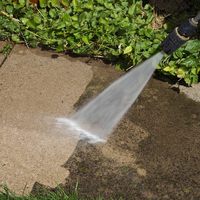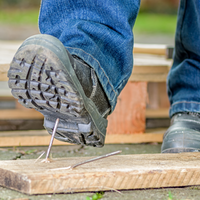When you use your workshop at home or working at your project site, using PPE could save you from injury or even death. Any time you turn on a power tool, use a saw to cut wood, or get on the roof of your house to make a roof repair, PPE can help protect you. PPE can reduce or prevent injury, If you have an accident. This can save you money on medical bills while also reducing the hardship that comes from sustaining an injury.
As contractors or DIY personal, we believe you make use of PPE. We want you to know more about it. In this piece, We tell you all about the importance of PPE, how to choose PPE, and when to use it.
What Is PPE?
PPE stands for personal protective equipment. PPE protects people from injury when they’re engaging in hazardous activities. It’s most often used in workplace environments to protect people from occupational hazards. Workshop safety equipment protects the lives of construction workers, window washers, healthcare workers and more.
Do you ever use a dust mask? That’s PPE.
Hard hat? PPE.
Safety glasses? PPE as well.
When you’re doing something in your workshop at home, safety gear can prevent you from sustaining serious injuries. Without PPE, you could be at greater risk to cut off a limb, lose an eye, or damage your hearing.
The Consequences of Not Having Safety Gear
PPE can prevent a terrible, life-threatening injury. It might surprise you to learn that PPE can also protect you from chronic conditions that can reduce your quality of life or terminate your life.One example: have you ever heard of a condition called silicosis? This disease affects people who work with and breathe in silica dust. Silica dust is released when you cut stone or drywall, work with grout, slice landscaping pavers, and more. It even comes from the sand that you mix with concrete. When the dust is inhaled, pieces of silica become embedded in the lungs. Eventually, the lungs develop scar tissue that makes breathing difficult. Advanced stages of this disease can kill.
But wearing the right PPE can prevent you from breathing in silica dust, and thus can prevent you from developing respiratory problems like silicosis. If you don’t wear PPE, you could do permanent damage to your body system.
Types of PPE
PPE comes in all different flavors. No matter what you’re doing in the shop at home, you can use PPE to help protect yourself from injury.
1- Eye and Face Protection
Eye and face protection can prevent you from being hit with flying particles. This type of safety gear can also prevent burns and blunt trauma. If you work with saws, hammers or yard tools, you probably need to have some eye and face protection in your shop.
- Safety Glasses
- Safety Goggles
- Face Shields
2- Hearing Protection
If you work with heavy equipment regularly, then you’re probably exposed to some loud noises. Over time, repeated exposure to very loud noises will damage your hearing. You can prevent this from happening by wearing hearing protection ear muffs. Be sure to wear good protective ear plugs and ear muffs to protect your hearing. You may even be able to find bluetooth hearing protection options to supply music or audio while you work.
- Ear Plugs
- Sound-Canceling Ear Covers
3- Masks & Respirators
Masks and respirators are necessary when you’re breathing in dust (like silica) or working with chemicals. But don’t confuse them, because they’re not the same thing, and there are many types of respirators and masks. Wearing the wrong thing at the wrong time could lead to a chronic condition or illness. Always check your MSDS sheet to make sure you’re using chemicals and safety gear properly.
- Particle Masks
- Respirators
4- Protective Clothing
Protective clothing can be used to pad your body, protect you from dangerous chemicals and heat, and even protect you from cut injuries. Below are the most common types of protective clothing.
- Knee Pads
- Protective Coverings
- Work Boots
- Work Gloves
- Hard Hats
Buy Here
Safety Equipment In the Workshop
PPE isn’t the only thing that can keep you safe in the workshop. In our showroom, We’ve got a lot of equipment that can prevent injuries and disasters. Here’s what I recommend:
Fire Extinguisher
Fire extinguishers come in different types for putting out different kinds of fires. Here’s the breakdown of the best fire extinguishers below:
- Class A: wood and paper, normal combustible items
- Class B: flammable liquids (gasoline, oil, etc)
- Class C: electrical fires
- Class D: flammable metals
I recommend assessing the type of fires you might start in your workshop. Keep as many fire extinguishers as you need. Label the wall above each extinguisher, to make it obvious which type of extinguisher should be used under each scenario. Check them quarterly, when you check your smoke detectors, and replace the fire extinguishers as they expire.
First Aid Kit
Should you become injured, you’re going to need a first aid kit. You can make your own or buy one pre-assembled. It should include, among other things, absorbent dressings, bandages, antiseptic wipes, aspirin, gloves, scissors, gauze roller and bandage roller.
Personalize your first aid kit to your needs. For example, if you regularly do activities that involve fire or extreme heat (like welding), burn spray and burn gel would be good items to include in your first aid kit. If you’ve never applied any of these remedies in the past, keep the instructions for each product in the first aid kit, so you’ll know what to do when the time comes to use it.
Check your first aid kit at the same time you check the fire extinguishers, to see if anything has been used up or expired. This is especially important if you’re not the only person who has access to it. Replace items in your first aid kit as needed.
Eye Wash Station
If you have a utility sink in your home, you can create your own eye wash station. Eye wash station attachments are available for sale in hardware stores and home improvement centers. If you don’t want to attach such a thing to your utility sink, you can also buy a portable eye wash station, which can serve the same purpose.
If you do a lot of cleaning or working with harsh chemicals, an eyewash station could prevent serious damage. Try it out at least once to ensure that you know how, so you can get down to the business of using it properly when the need arises.
How to Set Up a Workshop with Safety in Mind
Make your workshop as safe as possible! These tips will help.
- Keep your safety gear in easy reach.
- Keep multiples of your safety gear on hand if you often do DIY projects with family members or friends.
- If your children help you with your DIY projects, keep safety gear in their size.
- Make a checklist of safety gear and periodically check the items off your list to ensure that you can find them.
As soon as you’ve damaged used an item up, replace that item. If you use an item that is known to be disposable, dispose of that item after the first use.
How to Find Quality Safety Equipment
Inspect all safety equipment carefully before buying something. If safety gear reviews are available online, read the reviews. They rate a lot of safety equipment for protection against specific hazards, like the way ear plugs that are rated for protection against a certain number of decibels.
Read the packaging before purchasing your safety equipment. If no safety rating is given, or if the package can provide no information about the ways that product will protect you, this is a sign that they do not design the product for safety.
Ok, that’s our safety apparel advice. Injuries are no fun, so practice safety with every project. Good luck and be safe!
Credit to Choosetoolbox














